Effects of Temperature, Light and Digestive Fluid on the Stability of Major Arsenic Species in Antarctic Krill (Euphausia superba)
Simple Summary
Abstract
1. Introduction
2. Materials and Methods
2.1. Ethical Approval
2.2. Experimental Preparation
2.3. Storage Temperature Test
2.4. Light Exposure Experiment
2.5. In Vitro Simulated Digestion Experiment
2.6. Sample Pretreatment
2.7. Methods for pH Determination
2.8. Statistical Analysis
3. Results
3.1. Predominant Arsenic Species in Antarctic Krill and Derived Products
3.2. Effect of Storage Temperature on AsB Stability in Antarctic Krill
3.3. Effect of Illumination on AsB Stability in Antarctic Krill
3.4. Effect of In Vitro Digestion Simulation on the Stability of Major Arsenic Species in Antarctic Krill Oil
4. Discussion
4.1. Compliance and Speciation of Arsenic in Antarctic Krill Products
4.2. Influence of External Environments on Arsenic Speciation in Antarctic Krill
4.3. Future Perspectives
5. Conclusions
Author Contributions
Funding
Institutional Review Board Statement
Informed Consent Statement
Data Availability Statement
Conflicts of Interest
References
- Krafft, B.A.; Lowther, A.; Krag, L.A. Bycatch in the Antarctic Krill (Euphausia superba) Trawl Fishery. Fish. Manag. Ecol. 2023, 30, 154–160. [Google Scholar] [CrossRef]
- Qi, X.; Liao, E.; Zhao, K.; Regenstein, J.M.; Mao, X. Multi-Stage Countercurrent Process for Extracting Protein from Antarctic Krill (Euphausia superba). J. Food Sci. Technol. 2018, 55, 4450–4457. [Google Scholar] [CrossRef]
- Li, Y.; Peng, Z.; Tan, L.; Zhu, Y.; Zhao, C.; Zeng, Q.-H.; Liu, G.; Wang, J.J.; Zhao, Y. Structural and Functional Properties of Soluble Antarctic Krill Proteins Covalently Modified by Rutin. Food Chem. 2022, 379, 132159. [Google Scholar] [CrossRef]
- Ryabov, A.; Berger, U.; Blasius, B.; Meyer, B. Driving Forces of Antarctic Krill Abundance. Sci. Adv. 2023, 9, eadh4584. [Google Scholar] [CrossRef]
- Zhong, C.; Chen, P.; Zhang, Z.; Xie, C.; Zhang, S.; Sun, M.; Wu, D. The Use of Spaceborne Lidar to Map Antarctic Krill Distributions and Biomass in the Southern Ocean. Front. Mar. Sci. 2024, 11, 1287229. [Google Scholar] [CrossRef]
- Trathan, P.; Friedlaender, A.; Johnson, C.; Reisinger, R. The Fishery for Antarctic Krill—Conflicts between Industrial Production, Protection of Biodiversity, and Legal Governance. Mar. Policy 2025, 180, 106787. [Google Scholar] [CrossRef]
- Zhang, W.; Miao, A.-J.; Wang, N.-X.; Li, C.; Sha, J.; Jia, J.; Alessi, D.S.; Yan, B.; Ok, Y.S. Arsenic Bioaccumulation and Biotransformation in Aquatic Organisms. Environ. Int. 2022, 163, 107221. [Google Scholar] [CrossRef]
- Guo, Y.; Wang, L.; Zhu, W.; Jiang, Y.; Yao, L. Arsenic Content Analysis and Safety Evaluation of Antarctic Krill (Euphausia superba) and Its Products. Food Sci. 2018, 39, 182–187. [Google Scholar] [CrossRef]
- Mirzoeva, N.; Tereshchenko, N.; Paraskiv, A.; Proskurnin, V.; Stetsiuk, A.; Korotkov, A. Metals and Metalloids in Antarctic Krill and Water in Deep Weddell Sea Areas. Mar. Pollut. Bull. 2022, 178, 113624. [Google Scholar] [CrossRef]
- Arisekar, U.; Shakila, R.J.; Shalini, R.; Sivaraman, B.; Iyyappan, T.; Selvaraj, M.; Albormani, O.; Keerthana, M.; Renuka, V.; Kalidass, B. Multivariate Analysis and Seasonal Dynamics of Toxic Trace Elements and Antibiotics in Shrimp (Penaeus vannamei, Boon, 1931) Aquaculture: Impacts on Human and Environmental Health. Mar. Pollut. Bull. 2025, 219, 118326. [Google Scholar] [CrossRef] [PubMed]
- Ganie, S.Y.; Javaid, D.; Hajam, Y.A.; Reshi, M.S. Arsenic Toxicity: Sources, Pathophysiology and Mechanism. Toxicol. Res. 2024, 13, tfad111. [Google Scholar] [CrossRef]
- Feng, H.; Zhang, Y.; Fang, K.; Hu, Y.; Cheng, H. Investigating the Toxic Impacts of Various Arsenic Compounds on Hydroponics Lettuce (Lactuca sativa L.): Biomass, Arsenic Accumulation and Species Distribution. Water Air Soil. Pollut. 2025, 236, 287. [Google Scholar] [CrossRef]
- Luvonga, C.; Rimmer, C.A.; Yu, L.L.; Lee, S.B. Organoarsenicals in Seafood: Occurrence, Dietary Exposure, Toxicity, and Risk Assessment Considerations—A Review. J. Agric. Food Chem. 2020, 68, 943–960. [Google Scholar] [CrossRef] [PubMed]
- EFSA Panel on Contaminants in the Food Chain (CONTAM); Knutsen, H.K.; Åkesson, A.; Bampidis, V.; Bignami, M.; Bodin, L.; Chipman, J.K.; Degen, G.; Hernández-Jerez, A.; Hofer, T.; et al. Risk Assessment of Complex Organoarsenic Species in Food. EFS2 2024, 22, e9112. [Google Scholar] [CrossRef]
- Nzitiri Bwala, M.; Sabiu Imam, T.; Umar Zungum, I. Determination of Heavy Metals Contamination on Smoked Fish Sold at Some Fish Markets in Borno State, Nigeria. J. Chem. Health Risks 2023, 13, 135–143. [Google Scholar] [CrossRef]
- Zhang, G.; Xu, N.; Yang, X.; Zhang, Y. Effects of Washing, Blanching, Freezing Storage, and Cooking on Cadmium, Arsenic, and Lead Bioaccessibilities in Green Wheat. Food Meas. 2021, 15, 1973–1981. [Google Scholar] [CrossRef]
- Wang, N.; Ye, Z.; Huang, L.; Zhang, C.; Guo, Y.; Zhang, W. Arsenic Occurrence and Cycling in the Aquatic Environment: A Comparison between Freshwater and Seawater. Water 2022, 15, 147. [Google Scholar] [CrossRef]
- Zhao, F.; Liu, Y.; Zhang, F.; Dong, R.; Yu, W.; Zhang, H.; Han, X.; Gong, P.; Zhang, X.; Liu, Y.; et al. Simultaneous Determination and Distribution Analysis of Eleven Arsenic Species in Vegetables. Microchem. J. 2023, 193, 109168. [Google Scholar] [CrossRef]
- Fu, Y.; Yin, N.; Cai, X.; Du, H.; Wang, P.; Sultana, M.S.; Sun, G.; Cui, Y. Arsenic Speciation and Bioaccessibility in Raw and Cooked Seafood: Influence of Seafood Species and Gut Microbiota. Environ. Pollut. 2021, 280, 116958. [Google Scholar] [CrossRef] [PubMed]
- GB/T 35892-2018; Laboratory Animal—Guideline for Ethical Review of Animal Welfare. Standards Press of China: Beijing, China, 2018.
- Thomas, S.; Brightman, F.; Gill, H.; Lee, S.; Pufong, B. Simulation Modelling of Human Intestinal Absorption Using Caco-2 Permeability and Kinetic Solubility Data for Early Drug Discovery. J. Pharm. Sci. 2008, 97, 4557–4574. [Google Scholar] [CrossRef]
- GB 2762-2022; National Food Safety Standard—Limits of Contaminants in Food. China Planning Press: Beijing, China, 2022.
- Wiech, M.; Silva, M.; Meier, S.; Tibon, J.; Berntssen, M.H.G.; Duinker, A.; Sanden, M. Undesirables in Mesopelagic Species and Implications for Food and Feed Safety—Insights from Norwegian Fjords. Foods 2020, 9, 1162. [Google Scholar] [CrossRef] [PubMed]
- Raqib, R.; Akhtar, E.; Haq, M.A.; Sarker, P. Effects of Prenatal Exposure to Arsenic on T Cell Development in Children. Curr. Opin. Toxicol. 2023, 34, 100389. [Google Scholar] [CrossRef]
- Zheng, Y.; Ping, Z.; Xu, Y.; Li, X.; Guo, Q. Changes in the Autolysis Level, Muscle Stability and Myofibrillar Protein Properties of Antarctic Krill (Euphausia superba) during Refrigerated Storage. Int. J. Food Sci. Tech. 2022, 57, 7829–7839. [Google Scholar] [CrossRef]
- Xin, S.; Zhang, H.; Sun, J.; Mao, X. Characterization and Hydrolysis Mechanism Analysis of a Cold-Adapted Trypsin-Like Protease from Antarctic Krill. J. Agric. Food Chem. 2024, 72, 9955–9966. [Google Scholar] [CrossRef]
- Ni, L.; Jiang, C.; Guo, Q.; Chi, H.; Fan, C.; Shi, J.; Lin, N.; Liu, Z.; Chen, S. Metabolomics Analysis of Physicochemical Properties Associated with Freshness Degradation in Frozen Antarctic Krill (Euphausia superba). Food Res. Int. 2024, 183, 114190. [Google Scholar] [CrossRef]
- Jain, N.; Maiti, A. Fe-Mn-Al Metal Oxides/Oxyhydroxides as As(III) Oxidant under Visible Light and Adsorption of Total Arsenic in the Groundwater Environment. Sep. Purif. Technol. 2022, 302, 122170. [Google Scholar] [CrossRef]
- Liu, B.; Sui, J.; Feng, R.; Lin, H.; Han, X.; Sun, X.; Cao, L. Transformation of Arsenic Species from Seafood Consumption during in Vitro Digestion. Front. Nutr. 2023, 10, 1207732. [Google Scholar] [CrossRef]
- Pan, L.; Lin, F.; Zhu, Y.; He, R.; Liu, F.; Yan, X.; Chen, M. Determination of 6 Types of Arsenic Forms in Hirudo Medicinalis by HPLC-ICP-MS. Guangzhou Chem. Ind. 2025, 53, 88–90. [Google Scholar] [CrossRef]
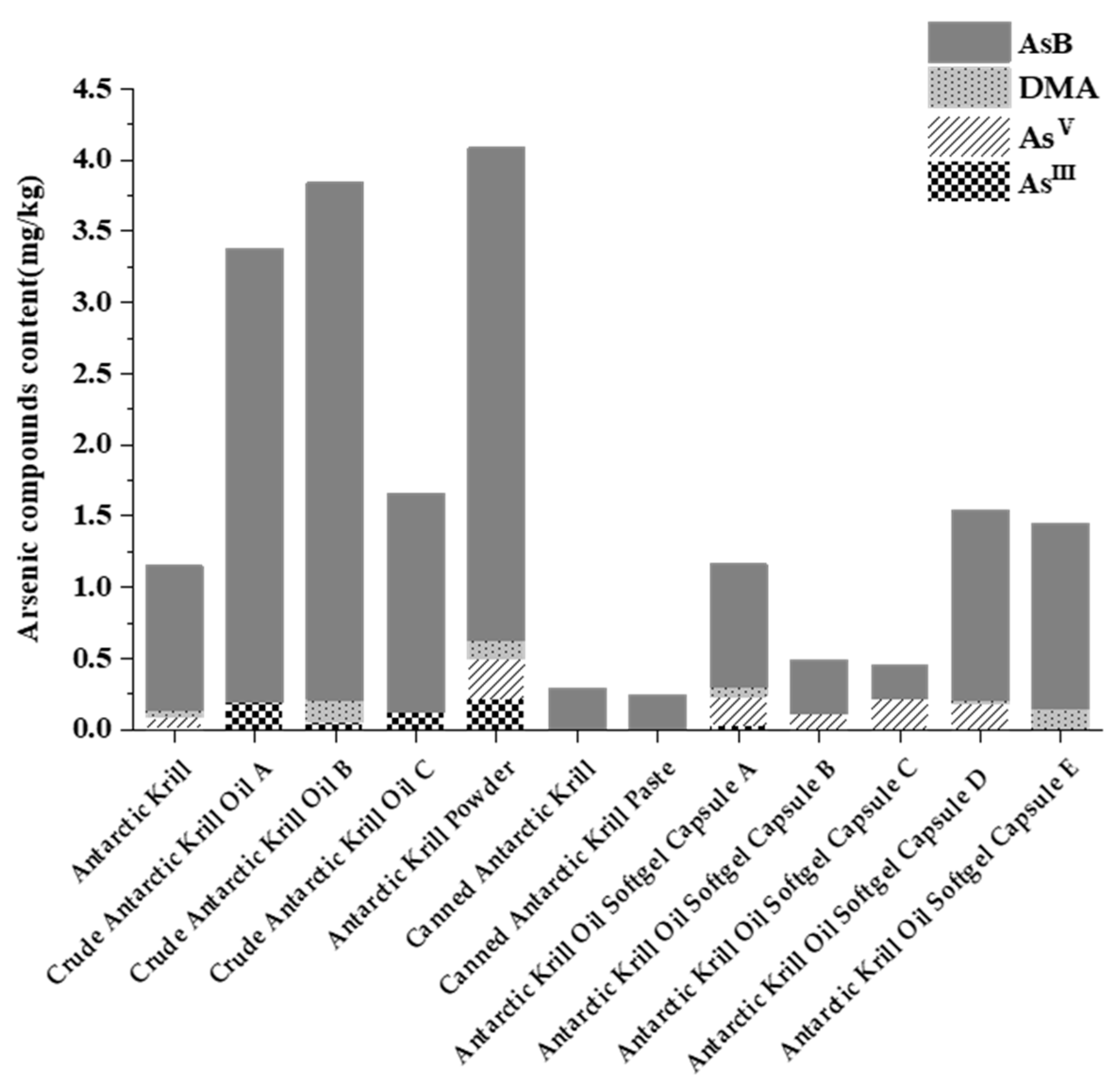
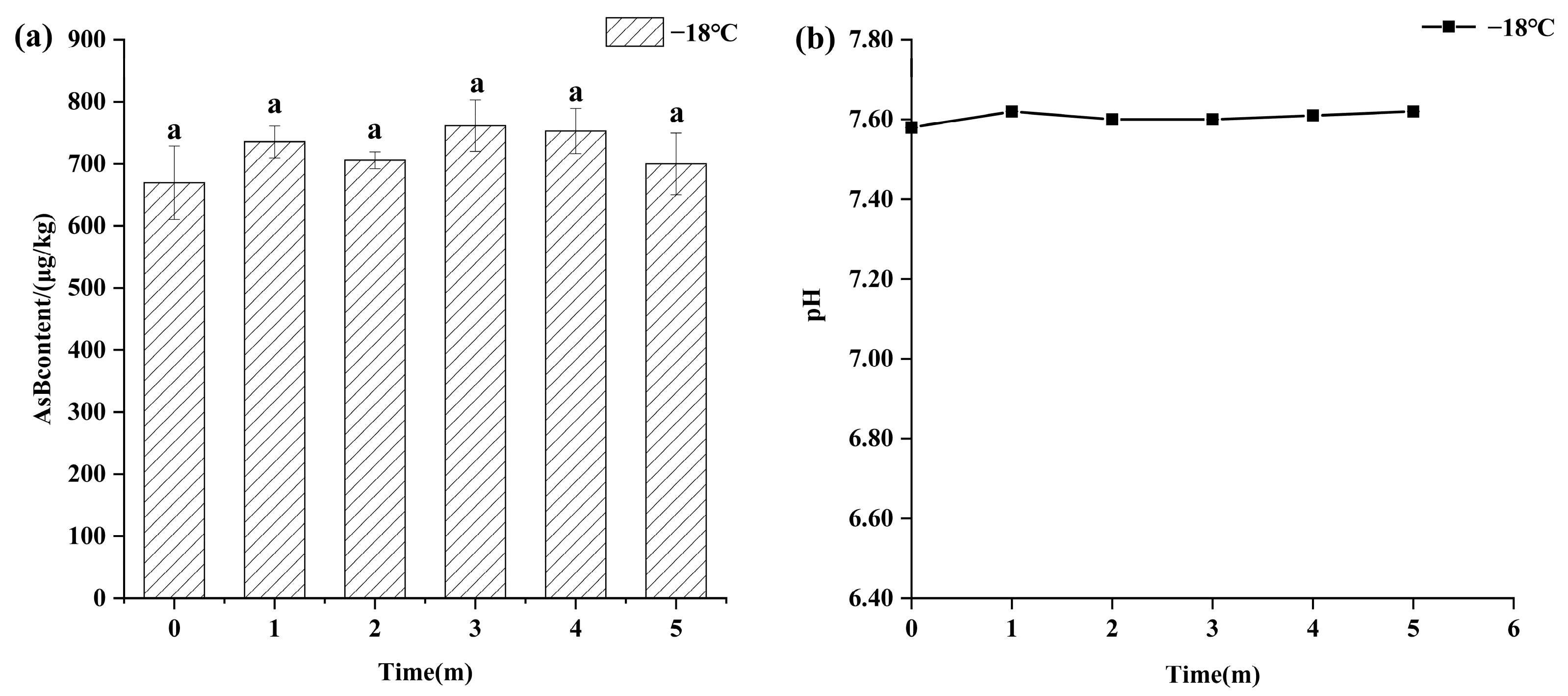
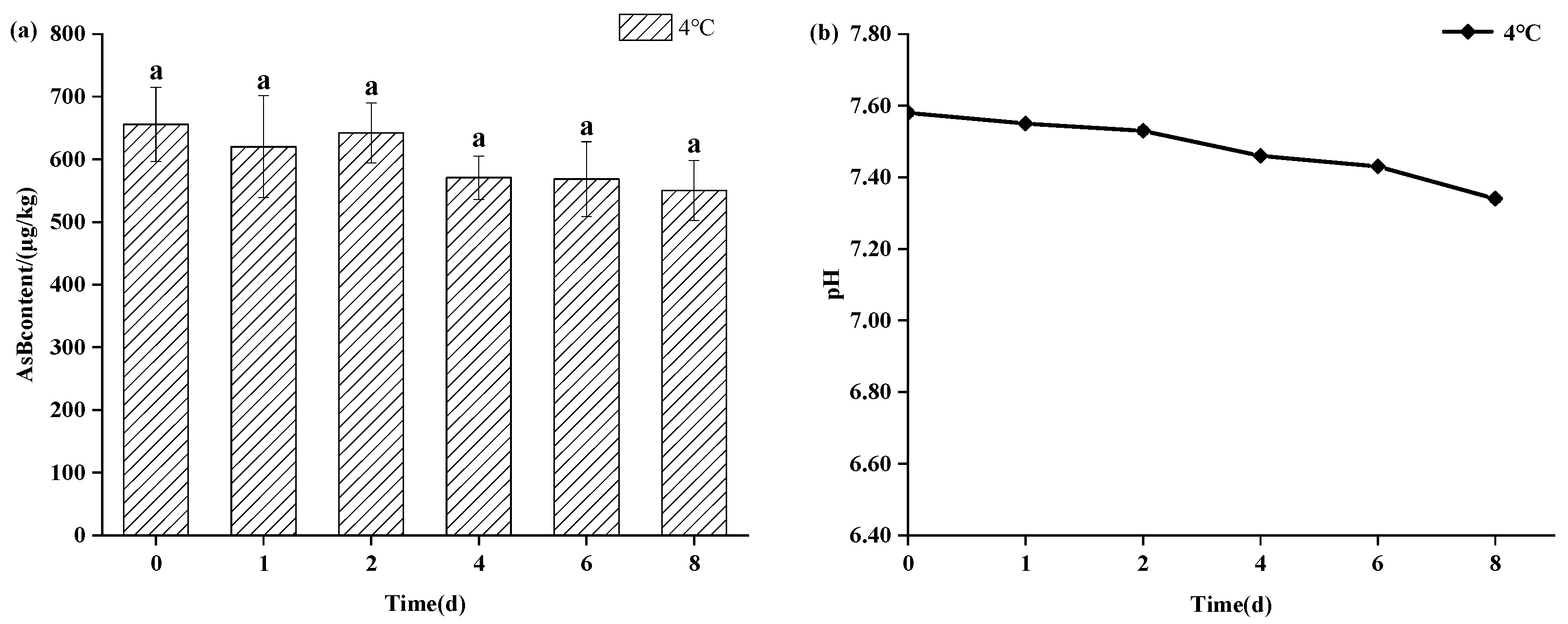

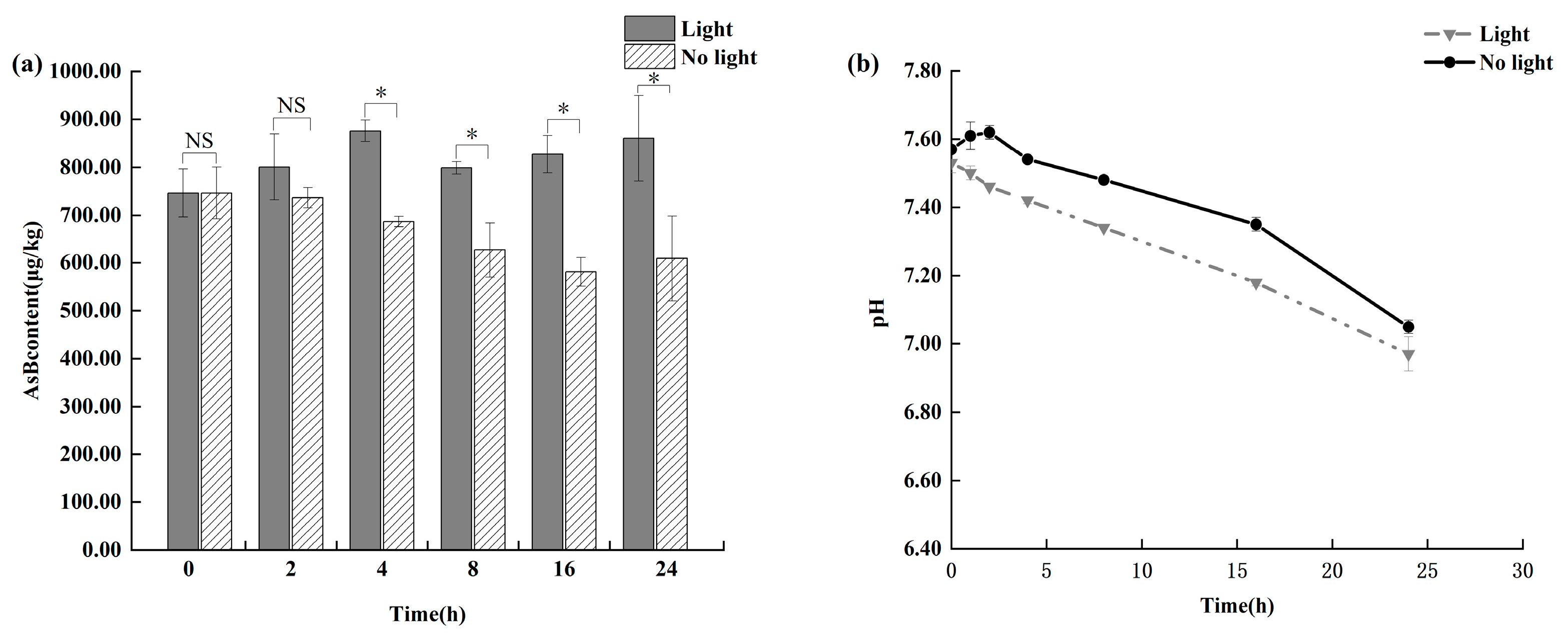
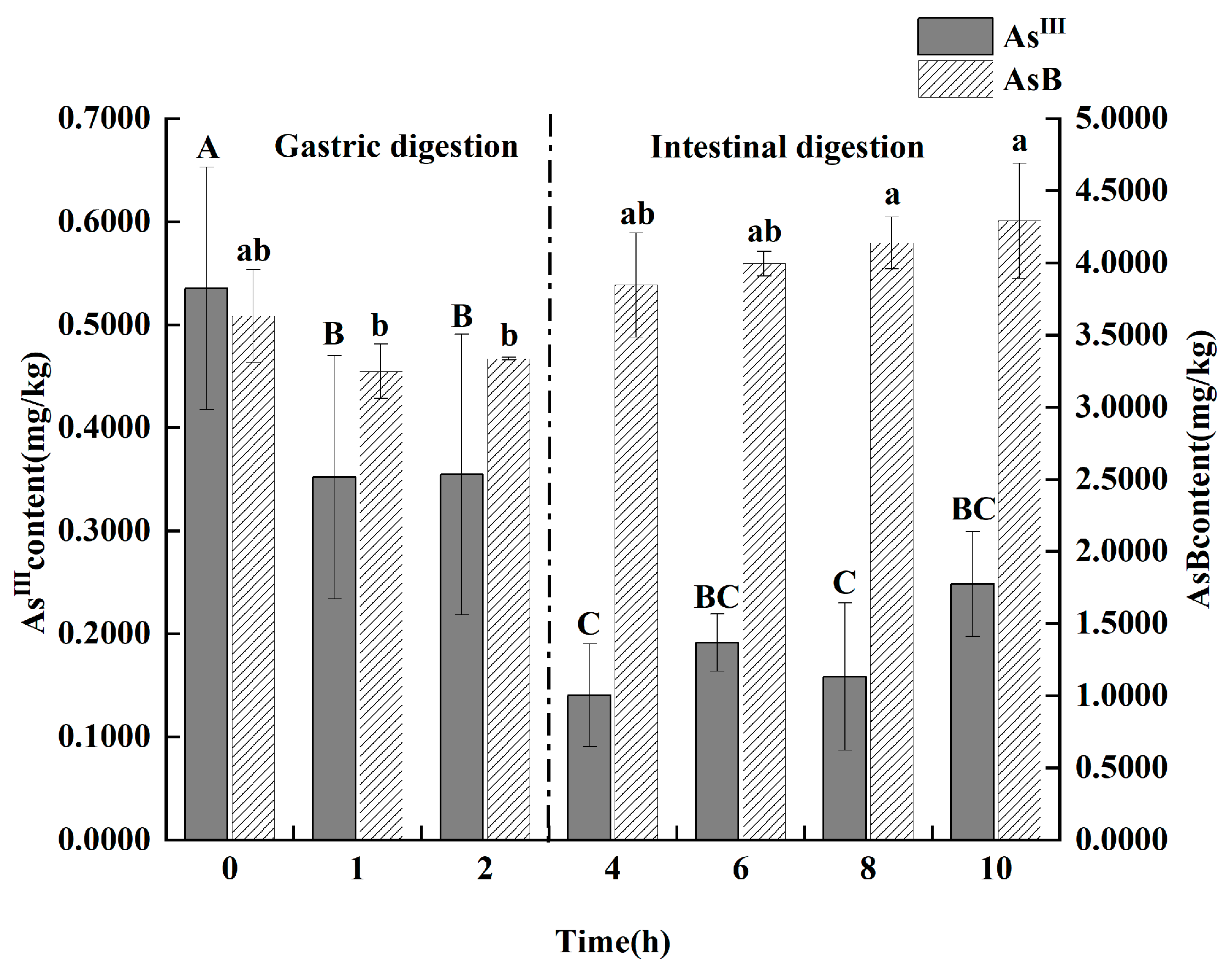
Disclaimer/Publisher’s Note: The statements, opinions and data contained in all publications are solely those of the individual author(s) and contributor(s) and not of MDPI and/or the editor(s). MDPI and/or the editor(s) disclaim responsibility for any injury to people or property resulting from any ideas, methods, instructions or products referred to in the content. |
© 2025 by the authors. Licensee MDPI, Basel, Switzerland. This article is an open access article distributed under the terms and conditions of the Creative Commons Attribution (CC BY) license (https://creativecommons.org/licenses/by/4.0/).
Share and Cite
Jiang, Z.; Zhang, H.; Ji, Y.; Yang, G.; Kong, C.; Wang, P.; Yuan, T.; Shen, X. Effects of Temperature, Light and Digestive Fluid on the Stability of Major Arsenic Species in Antarctic Krill (Euphausia superba). Animals 2025, 15, 3148. https://doi.org/10.3390/ani15213148
Jiang Z, Zhang H, Ji Y, Yang G, Kong C, Wang P, Yuan T, Shen X. Effects of Temperature, Light and Digestive Fluid on the Stability of Major Arsenic Species in Antarctic Krill (Euphausia superba). Animals. 2025; 15(21):3148. https://doi.org/10.3390/ani15213148
Chicago/Turabian StyleJiang, Zhongquan, Haiyan Zhang, Yunyun Ji, Guangxin Yang, Cong Kong, Peng Wang, Tao Yuan, and Xiaosheng Shen. 2025. "Effects of Temperature, Light and Digestive Fluid on the Stability of Major Arsenic Species in Antarctic Krill (Euphausia superba)" Animals 15, no. 21: 3148. https://doi.org/10.3390/ani15213148
APA StyleJiang, Z., Zhang, H., Ji, Y., Yang, G., Kong, C., Wang, P., Yuan, T., & Shen, X. (2025). Effects of Temperature, Light and Digestive Fluid on the Stability of Major Arsenic Species in Antarctic Krill (Euphausia superba). Animals, 15(21), 3148. https://doi.org/10.3390/ani15213148






